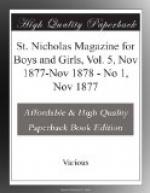“And all I remember is friends flocking
round,
As I sat with his head ’twixt my
knees on the ground,
And no voice but was praising this Roland
of mine,
As I poured down his throat our last measure
of wine,
Which (the burgesses voted by common consent)
Was no more than his due who brought good
news from Ghent.”
(To be continued.)
MASTER MONTEZUMA.
(With Illustrations copied from Mexican Hieroglyphics.)
By C.C. HASKINS.
[Note.—Montezuma II., the last of the Aztec (or native Mexican) emperors, was born about 1480. He was taken prisoner by Hernando Cortes, the commander of the Spanish army which conquered Mexico, and, in the hope of quelling an insurrection which had arisen among his former subjects, he consented to address them from the walls of his prison. Stung by the apparent desertion of their leader to the cause of the enemy, the Mexicans assaulted him with stones and other missiles. He was struck on the temple by one of the stones, and died from the effects in a few days. The illustrations are true copies of old Mexican pictures, which appeared originally in the “Collection of Mendoza,” a work frequently referred to by all writers on ancient Mexico.—C.C.H.]
The Emperor Montezuma was a great man, and historians have recorded much about him, but of his earlier life, when he was plain Master Montezuma, comparatively little is known of this rising young gentleman.
Master M. commenced his earthly career as a crying baby, in the year “one cane,” which, when properly figured down according to the Gregorian calendar, would be about the year of our Lord 1480.
No sooner had Master M. reached the fourth day of his existence, than the nurse, under instructions from his anxious mamma, took off what few clothes the poor boy had on, and repairing to the baptismal font in the yard, sprinkled cold water upon his naked breast and lips, presented his credentials in the shape of offerings to propitiate the gods of war, agriculture, etc., whose names you will find further along in this history, repeated a prayer in which “the Lord was implored to wash away the sin that was given him before the foundation of the world, so that the child might be born anew,” and told the three little boys who sat near by, what Master M.’s name was to be. The three little boys left off eating their parched corn, and boiled beans, repeated the name, and the little baby was christened.
Now, if Master M. had been a girl—which he was not—the offerings would have been a mat, a spinning machine and a broom, all of which would have been buried under the metate, the stone where corn was ground. As it was, the offerings were implements of war, articles of metal, pottery, etc., and these were buried, as near as they could guess at the location, where they either hoped or feared there might some day be a battle with their enemies.




